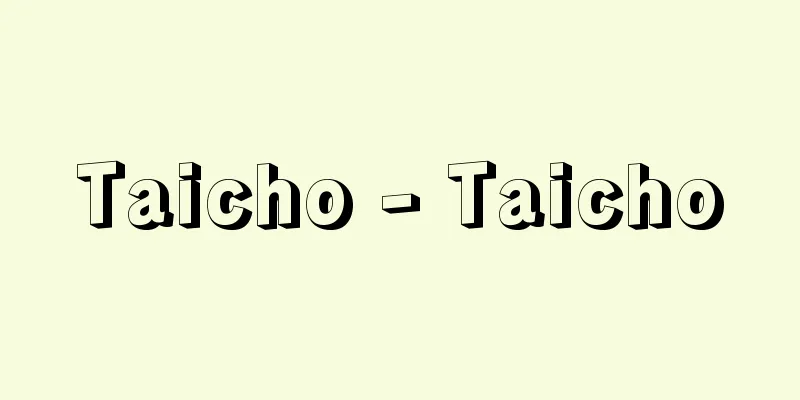Taicho - Taicho

|
Year of death: Jingo Keiun 1.3.18 (767.4.20) Year of birth: Tenmu 11 (682) He was a mountain ascetic in the mid-Nara period, and is said to have been the founder of Mt. Hakusan. His birth and death years are according to the Biography of Priest Taicho, but there is also a theory that he was born in 693 (the 7th year of Jitō). He is said to be the second son of Mikami Yasukaku of Asotsu, Asuwa County, Echizen Province (Fukui City). He was called the Great Virtue of Echigo. The Eleven-Headed Kannon appeared to him in a dream, and he began to practice asceticism at Mt. Echigo from his youth. Looking at Mt. Hakusan from Mt. Echigo, he longed to climb the mountain. In one of his dreams, the Great Bodhisattva Hakusan Myōri appeared to him in the form of a noblewoman, inviting him to climb the mountain. In 717, he set out to climb Mt. Hakusan for the first time, accompanied by two disciples, Ga-gyo from Noto, who used the "flying bowl technique" of collecting rice by flying a bowl, and Jōjō-gyo, a former boatman from Dewa. When he reached the top of the mountain, the King of Nine Dragons appeared from the pond, but when he realized that it was not the real him, he transformed into the Eleven-Headed Kannon. He secluded himself on Mt. Hakusan with his attendants and continued his training for three years. He became famous for his climbs of Mt. Hakusan, and in the sixth year of the Yoro era, he was summoned to the Imperial Court, where he performed a ritual to cure Emperor Gensho's illness, which led to his successful recovery. He was appointed the Emperor's guardian monk and bestowed the rank of Zen master. As a result, the miraculous powers of Hakusan Gongen became known throughout the capital. After this, he took the name Shin'yū. In the second year of the Jinki era (725), he met Gyoki, who had climbed Mt. Hakusan, and is said to have told him the origins of Hakusan Gongen. In the ninth year of the Tenpyō era (737), he was given the rank of Daiosho after he quelled a smallpox epidemic by practicing the Eleven-Headed Kannon ritual. He was also bestowed the title Taisho, but of his own volition he changed the title to Shou. <References> "Genko Shakusho" and "Biography of Priest Taicho" (Kunimitsu Kawamura) Source: Asahi Japanese Historical Biography: Asahi Shimbun Publications Inc. About Asahi Japanese Historical Biography |
|
没年:神護景雲1.3.18(767.4.20) 生年:天武11(682) 奈良中期の山岳修行者で,白山の開山者と伝えられる行者。生没年は『泰澄和尚伝記』によるが,生年は持統7(693)年説もある。越前国足羽郡麻生津(福井市)の三神安角の次男とされる。越の大徳と呼ばれた。十一面観音が夢に現れ,少年期から越知山に通って修行した。越知山から白山を眺め,白山登拝を念願していた。夢想の中に,白山山頂の白山妙理大菩薩が貴女の姿で現れ,白山へ登るよう招いたため,養老1(717)年,鉢を飛ばして米を手に入れる「飛鉢法」を使う能登出身の臥行者と出羽出身の元船頭の浄定行者のふたりの弟子を連れ,初めて白山登攀を志した。山頂に登ると,池の中から,九頭竜王が姿を現したが,それが本身ではないことを見抜くと,十一面観音に変貌した。白山には侍者と共に,3年間籠もって修行を続けた。この白山登攀で有名になり,養老6年に宮廷に召されて,元正天皇の病気治癒の加持祈祷を行い,平癒させ,天皇の護持僧に任じられ,禅師の位を授けられた。これによって白山権現の霊験が都で知れわたるようになった。こののち,神融と称した。神亀2(725)年,白山に登った行基と出会い,白山権現の由来を伝えたといわれる。天平9(737)年には,疱瘡の流行を十一面観音法を修して鎮めたことにより,大和尚位を授けられた。また泰証の号を贈られたが,自ら望んで証を澄と改めたという。<参考文献>『元亨釈書』『泰澄和尚伝記』 (川村邦光) 出典 朝日日本歴史人物事典:(株)朝日新聞出版朝日日本歴史人物事典について 情報 |
Recommend
Unkokuha
Founded by Unkoku Togan in the Momoyama period, t...
Sengakuji Temple - Sengakuji
A Soto sect temple in Takanawa, Minato Ward, Toky...
Castellammare del Golfo (English spelling)
A fishing port town on the bay of the same name in...
Draft - Kissui
The depth below the waterline of a ship, i.e. the ...
Temple money - Terase
A fee that a gambling gambler takes from customer...
Horseback archery
...Even after the mid-Muromachi period, when the ...
Definite bud
…Plant buds are usually formed in fixed locations...
Farmland Drainage - Uchihaisui
Removing excess water from the surface and ground ...
medullary pyramid
… [Pyramidal tract movement disorder] The axons o...
Machinery credit insurance
In order to contribute to the modernization of fac...
Coronado, Francisco Vásquez de
[Born] 1510. Salamanca Died September 22, 1554, Me...
Dizaboulos
...below them were the Little Khan, the Yabugu an...
Nine Stars
This is a superstition that was introduced to Jap...
Kaiso - Kaisou
… A lute-type stringed instrument consists of a m...
Stadler, LJ
...Currently, this field studies the structure, r...









